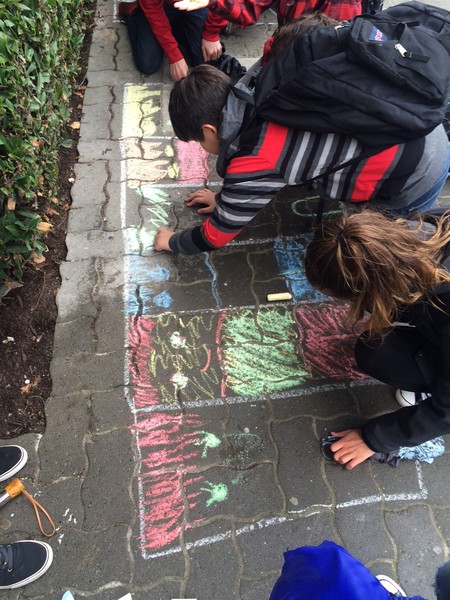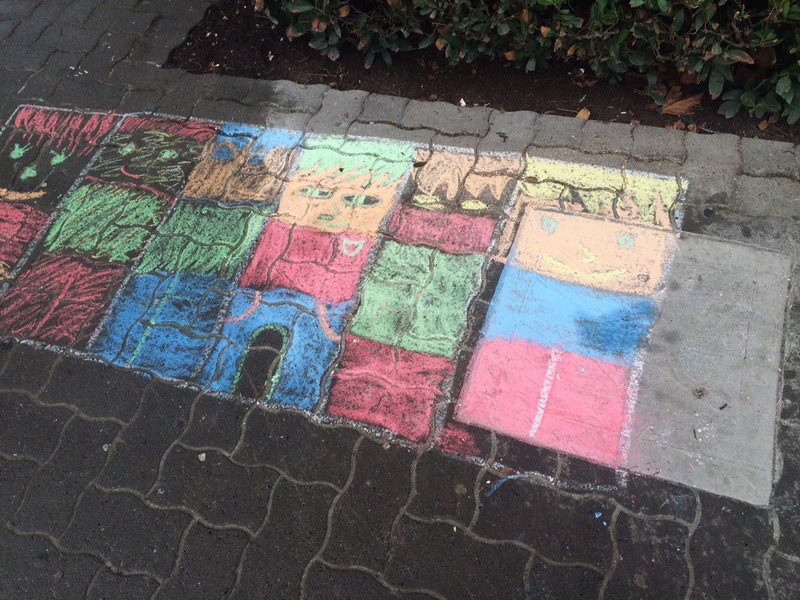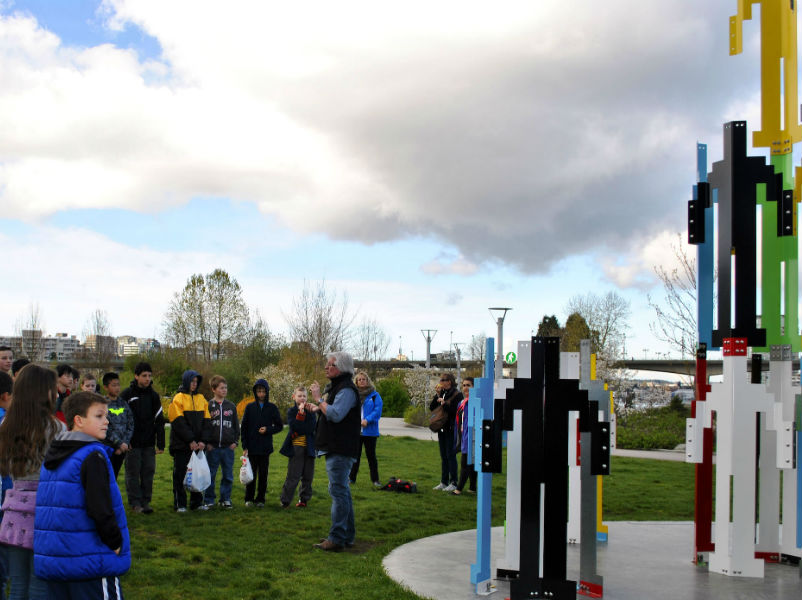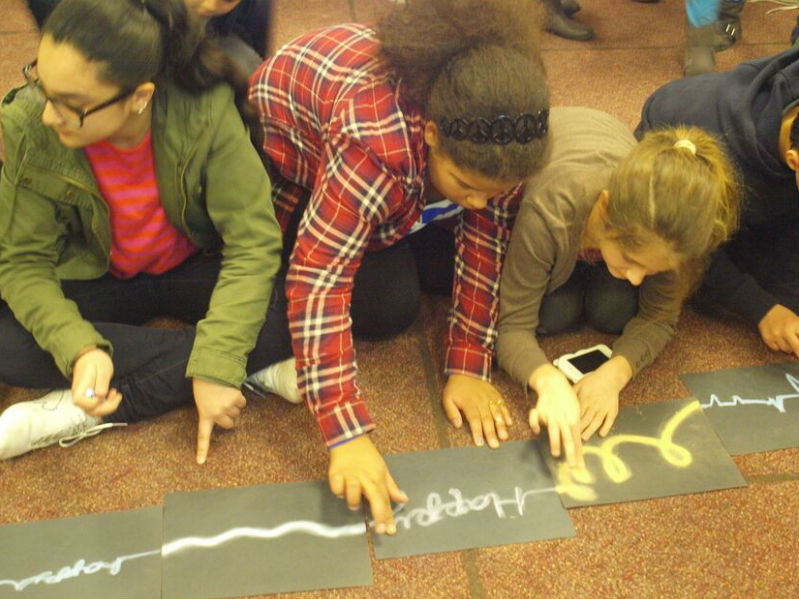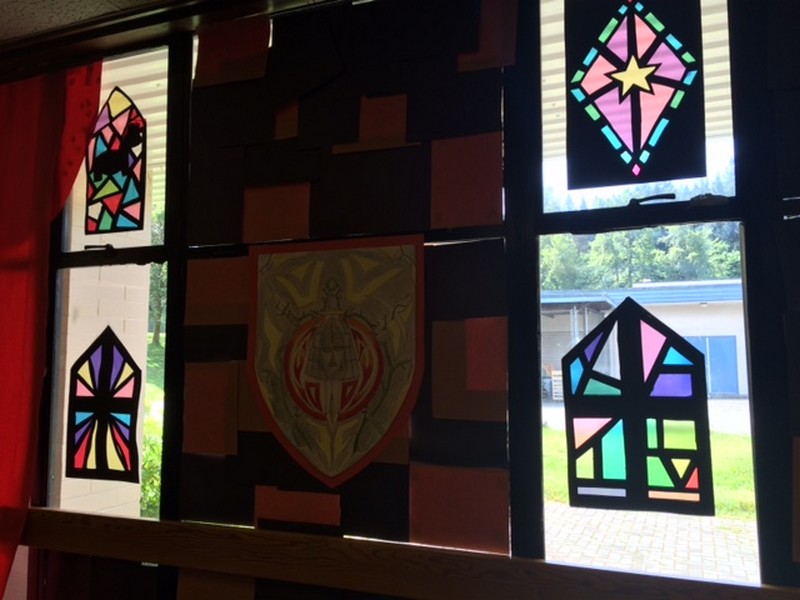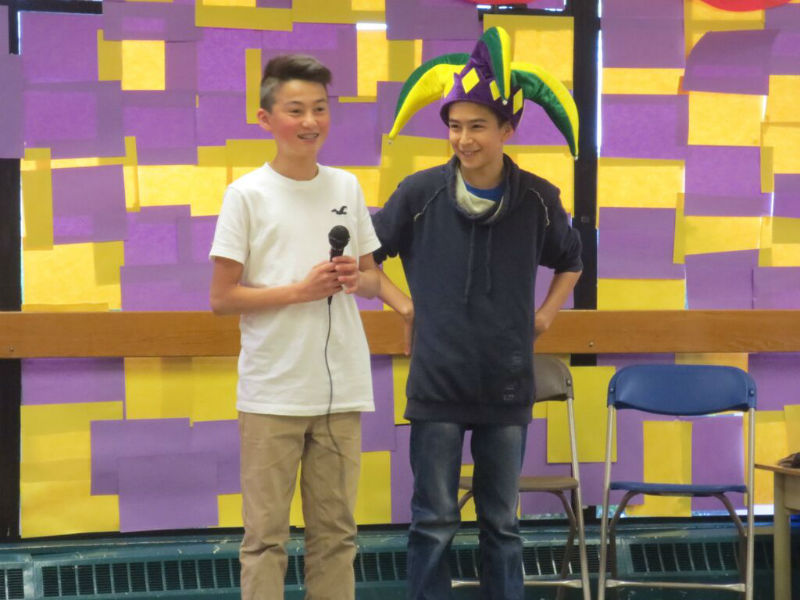École Moody Middle School of the Arts (EMMSOTA)
Arts Education, Language Arts, Social Studies
School: École Port Moody School of the Arts
Teacher: Trevor Kolkea, Principal
Artist Collaborators: Adrian Walker and Laura Barron
Class: Whole School
Overview
A school-wide celebration of Medieval Times with presentations of learning from every student to create a school-wide engagement in the arts.
Connection to the Vancouver Biennale Exhibition
Connecting the Trip to Learning in Class: The experience and learning about the Biennale installations: Human Structures Vancouver, Giants, and Love Your Beans inspired teachers and students to make connections for installations of their own. The installations are just one layer of the inquiry providing a hands-on exposure to interacting with art. It launched the desire for students to look for functional aspects of art from Medieval times such as weaponry, castle design and other inventions. The field trip opened their thinking toward how art can have a message and purpose beyond just looking beautiful.
Connecting to Vancouver Biennale Theme of Open Borders / Crossroads Vancouver: This inquiry opens borders in a rich and powerful way. It brought the school together on a learning journey. Classes all contributed, collaborated and learned together under a common goal. This project brought all three grades together, all three pods together and bring staff members together to explore the medieval world and the role of art at that time.
A very important structure this inquiry plays is allowing an Arts Education outcome to provide the central enduring understanding where Language Arts and Social Studies can be woven into the learning content. The vision of École Moody School of the Arts is opening the borders of our subjects to invite innovative art experiences and connections. This project provides an opportunity to look at the world from a different era and learn about the influence of art, the impact on culture and how that is compared and contrasted to our world today.
Other Resources
“Robin Hood and Friends” – musical and study materials by Debbie Campbell.
Favorite medieval tales [ Book ] 398.2 OSB Osborne, Mary Pope.
Castles and cathedrals : the great buildings of Medieval Times [ Book ] 723 HIL Hilliam, David.
Giotto and medieval art : the lives and works of the medieval artists [ Book ] 759.5 COR Corrain, Lucia.
Living in– the Middle Ages [ Book ] 940.1 BAN series consultant editor, Norman Bancroft Hunt.
Pathways, Civilizations Through Time – Michael Cranny
Patterns of Civilization – Burton F. Beers
www.learner.org/interactives/middleages/
Interactive Middle ages site
www.bl.uk/learning/histcitizen/medieval/medievalrealms.html
A collection highlighting various aspects of medieval society/realms
www.historylearningsite.co.uk/black_death_of_1348_to_1350.htm
Black Death and impact on Europe
Rosenwein, B. (2014). A Short History of the Middle Ages. Toronto, ON: UT Press.
The Oxford dictionary of the Middle Ages (2010). Robert E. Bjork (Ed.). Oxford, NY: Oxford University Press.
Snyder, J. (2006). Art of the Middle Ages. Upper Saddle River, NJ: Prentice Hall.
BIG IDEAS
Building Artistic Connections from Medieval Times:
Encountering perspectives that challenge our point of view expands our understanding of others.
Discoveries and innovations can result in progress or decline.
Guiding Questions
How does a specific artistic innovation impact the culture that it was created in?
How does a specific artistic innovation of the past influence us today (legacy)?
How is meaning communicated through art over the ages?
Learning Process/Inquiry Challenges:
Making Musical Connections with the Guiding Question: Discoveries and Innovations can result in Progress or Decline and Vancouver Biennale Art Installations:
Framing this around the invention of the Printing Press, explore the question: What does music look like? Mood Line Drawings, Sing Line, Conduct Line
What music might be visually represented by the Vancouver Biennale art installations that the class plans to visit
Can you see music’s structure?
Listen to four pieces (pop examples), and ask students to select their favorite, to create natural working groups for subsequent activities.
Listen to one piece (parallel classical form) and form Human Tableau to reflect structure of music.
Show Samples of Graphic Scores & Musical Notations Thru the Ages
Have Students create their own graphic score responses to their group’s piece.
Final Presentations by small groups to large group
Art Inquiry Experience
Making meaningful links between the Biennale sculptures and the Middle Ages by looking to the more visible connections between the size and scale of Cathedrals (‘monument’ and the ‘monumental’) and asking the question “what are our modern day cathedrals”?
On another note, the larger than life embodiment of the human figure in the form of a Knight, finds a more humble cousin in the representation of the figure in the design of Human Structures Vancouver.
The jester-like humour in Love your Beans that reminds us to laugh even in the face of troubling times and adversity.
Linking Activity
Each student used three index cards, one for each art installation, to represent their experience on the card. The idea is for students to express what they have learned, thought about, imagined, experienced in any way they feel is appropriate. They used words, pictures, images, etc. to express a true representation or an inspiration.
Team Inquiry Focus
Students were divided into 8 groups where each group was given a card with a specific team inquiry focus. Students discussed a question and possible responses.
Where do artistic inspirations originate from the community?
What is an art installation?
Would installations like you saw on our field trip be created in Medieval times?
How is art defined in different times/eras?
What is the role of art at different during different eras?
How are specific art pieces of today influenced from the Medieval time period?
How is art influenced from the Medieval time period?
Explore artistic inspirations from the Medieval era
Develop Inquiry questions and activities to learn about the perspectives, values and purpose of a specific piece of art.
What was/can be considered art in Medieval times?
Exploring Medieval castles and their function.
Exploration of dance and movement from the Medieval era.
Exploring clothing and design from Medieval times.
Defining the culture of Medieval Times and our cultures in Canada today
Cross-Curricular Access
- Language Arts: Engage actively as readers and listeners to construct meaning, deepen thinking and comprehension, and promote inquiry. Use a variety of communication forms including oral, written, visual, and digital. Use oral language to explore and express ideas, communicate clearly, and evoke emotion.
- Arts Education: Create artistic works collaboratively and as individuals using ideas inspired by imagination, inquiry, experimentation, and purposeful play; manipulation of elements, principles, and design strategies to create mood and convey ideas in the arts; describe, interpret, and respond to works of art; experience, document, perform, and share creative works in a variety of ways
- Social Studies: Assess and compare the significance of people, places, events, and/or developments over time and place and from different perspectives (significance); artistic and cultural expression during this time period; representations of the world according to the religions, spiritual beliefs, myths, stories, knowledge, and languages of past civilizations and cultures
Student Creation
Promotion of the School of the Arts – leaving a legacy of our first year as EMMSOTA through a development of school Art Gallery piece
Artistic representation that communicates an understanding of a time period; religion, ethnicity, pervading culture of the time
Musical – drama, music/singing, dance that connects to a Medieval period
Medieval Feast and Fair
Digital Media Artistic creations representing today and influenced from past studied culture
Reflection
Artist – Laura Baron
The BIG IDEA project, Building Artistic Connections From Medieval Times, for which I facilitated a number of Artist in the Classroom sessions at the Port Moody Middle School of the Arts, provided a unique experience, for me as an artist educator, on many levels. Initially inspired by the Guiding Questions, “How is meaning communicated through art over the ages?” and the Enduring Understanding, “Discoveries and innovations can result in progress or decline”, my engagements with the EMMSOTA students began with an exploration of the relationships between visual art and music. Different to my previous Biennale projects, I had the opportunity to work with the entire student body (250+ Grade 6-8 students), all of whom were both preparing to visit three Biennale installations in False Creek, and who were involved in a school-wide Middle Ages inquiry. In line with our proposal questions, we naturally considered how the invention of the Guttenburg printing press, in 1440, vastly altered the way that people interacted with, documented, and passed down music to future generations. This mode of inquiry allowed students to examine a variety of music notational systems that have emerged over the ages, and it also gave them a chance to, themselves, respond to various musical excerpts with graphic and sculptural creations that reflected their forms. Additionally, students had the chance to discover parallels between musical structures from a half millennia ago to the music of their time. This cross-disciplinary critical thinking, about new and old art forms, certainly primed them to more thoughtfully experience and respond to the Biennale artwork that they saw on their field trip to Vancouver. And consequently, as they immersed more deeply into their own school-wide Middle Ages inquiry, I believe that the lateral thinking which our initial arts activities cultivated, (as well as those led by my colleague, Adrian Walker), inspired them to more creatively dream big about the ways in which they could deliver their Presentations of Learning in highly artful ways. After Adrian and my first sessions, as well as his subsequent guidance on their VB installation visits, the students took the next month to conceive the form that their Presentations would take. Collectively, they agreed to produce Medieval Feasts – one for each pod of 3 classes at their school. During this time, the EMMSOTA teachers continued addressing our original guiding questions, and I am sure that their own personal reflections will better shed light on the ways in which our proposals’ Enduring Understanding was imparted throughout this process. However, ultimately, in the latter part of this project, Adrian and I were less directive in shaping the project outcome, and more responsive to the student and school needs. This is because the faculty determined that this very ambitious and multi-dimensional undertaking of producing three separate Medieval Feasts would require considerable additional guidance from Adrian and I, who were both asked to lend our expertise to the students’ development of a multitude of feast elements. This involved the creation of all of the set pieces, props and costumes, as well as the preparation of historical and original music, dance, poetry, and theatrical works. I invited the opportunity to exercise my interdisciplinary skills, as a professional musician and writer who also has considerable theatre and movement experience. Throughout this process, I was immensely impressed with the autonomy that students demonstrated in the creation of their feast contributions. Thus, I only had to offer some helpful prompts to get their creative processes going, as well as constructive feedback as they prepared their performative elements. I was also very grateful to work with the highly flexible and open-minded faculty at EMMSOTA, who balanced vision and leadership with a refreshing trust of their students and us, as visiting artists, to take our own initiative. As a result, students who often had little or no prior experience with the particular artistic endeavors that this feast required of them, demonstrated greatly enhanced skills and confidence in their feast presentations. Additionally, the artistic lens through which they were able to deepen their knowledge of the Middle Ages fostered a level of commitment and enthusiasm for the curricular topic that I have rarely observed. And isn’t this what arts engagement is ultimately all about!
Artist – Adrian Walker
The Big Ideas project, Building Artistic Connections From Medieval Times, gave me the opportunity to begin a journey through a culture and history of the past and with the help of the students from EMMSOTA, map out a line of inquiry and investigation that was able to make connections to the art and culture of the modern era. Initially inspired by the Guiding Questions, “How is meaning communicated through art over the ages?” and the Enduring Understanding, “Encountering perspectives that challenge our point of view expands our understanding of others”, my involvement began with a look into the roles played out by the visual arts in developing a form of visual literacy beginning with the Middle Ages and reaching as far forward as the present public sculpture that is part of the Vancouver Biennale. Along with my co-collaborator Laura Barron, we started the program by meeting with the 250+ Grade 6-8 students in small groups. Each one of us presented a workshop/discussion addressing the historical connections between art, architecture and music (Laura’s area of expertise). The purpose of my component for the discussion was to assist the students in developing a language with which to ‘talk about art’. As a sideline, it was clear to me at this point that I’d be the artist collaborator going on the field trips to the sculpture location at False Creek, so I was determined to provide the students with a critical language with which to ‘see’ the work and make connections back through art history to the cultural works of the Middle Ages. During my workshop presentation, I made a point of incorporating the terms ‘monument’ and ‘monumental’ into a discussion of art, architecture and artists as varied as Notre Dame Cathedral, Damien Hirst (Circle Paintings), the earthworks of Robert Smithson (Spiral Jetty) as well as the Biennale sculptures Giants, Love Your Beans and Human Structures. The workshop was followed by our field trip to False Creek. The location where I held my talks was athlete’s village and the site of Human Structures by Jonathan Borofsky. Given that EMMSOTA was also involved in preparing for a Medieval Feast as one of the core components of their project, early discussion centered around connections and references to objects or symbols that might be emblematic of the culture of the Middle Ages. After close inspection of the actual human forms in Human Structures, students made references to the armor worn by knights, with the formal pose chosen by Borofsky being indicative of the lack of flexibility in the heavy armor itself. Technology got a nod in the guise of a digital reference some saw inherent in the pixilated edges of the human form. There was even a comparison made between the similarity of repetitive partially pixilated figures with the architecture surrounding the sculpture – noting that the adjacent condos had a surface that was essentially four formal arrangements repeated over and over again – much like the human forms in the Borofsky piece. And finally, an historical reference was made to the hierarchical structure of the feudal system as students could see echoes here in the various levels of figures in the human structures themselves. Students argued that with cooperation, a group could achieve great heights but not without the support and stability of the lower more numerous level of figures supporting the upper tiers of figures. A final point that wasn’t lost on anyone was just how poignant and appropriate this was, given that not long ago this site housed a multitude of Olympic athletes, many of whom k new only too well the value of working together as a whole in the support of a greater goal and dream.
With the final days of the project devoted to making the three Medieval Feasts a success, much of the time spent was on the preparation of the dining hall, the musical and theatrical acts as well as the games that were to follow. This group experience shared in part by all participating teachers, students, Laura and myself, was also a cornerstone to the presentations of learning component. Each Feast night provided the opportunity for the students to share their observations, research and imagination in a terrific display of projects ranging from the evolution of literacy and the Guttenberg press, to the changes in the development of weaponry through the ages up to and including modern warfare. The lasting memory I come away with is that moment when I can see a student getting completely lost in the sheer joy and excitement of being involved in something bigger than him/herself, especially when they know just how much they’ve helped to create this experience for others.
